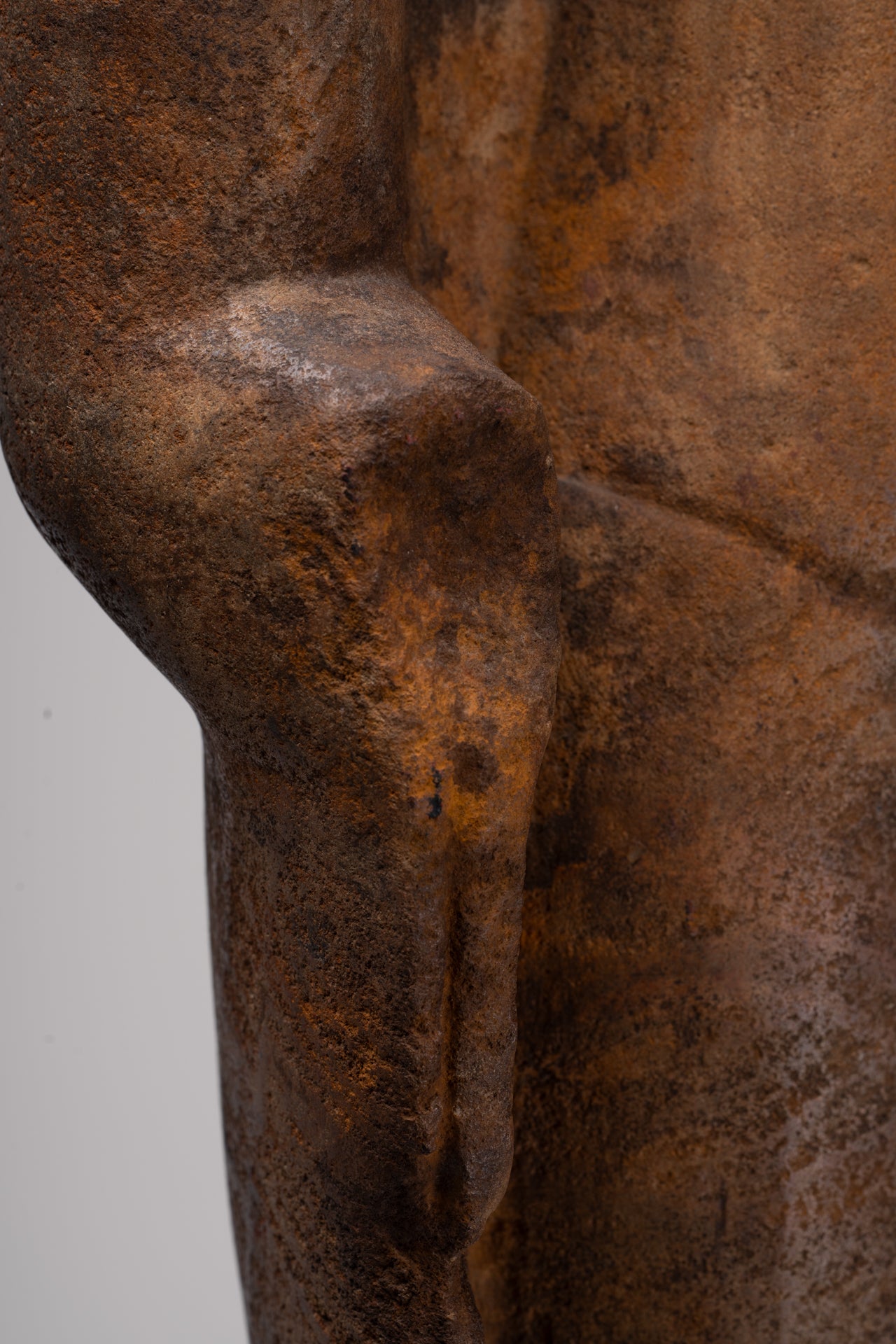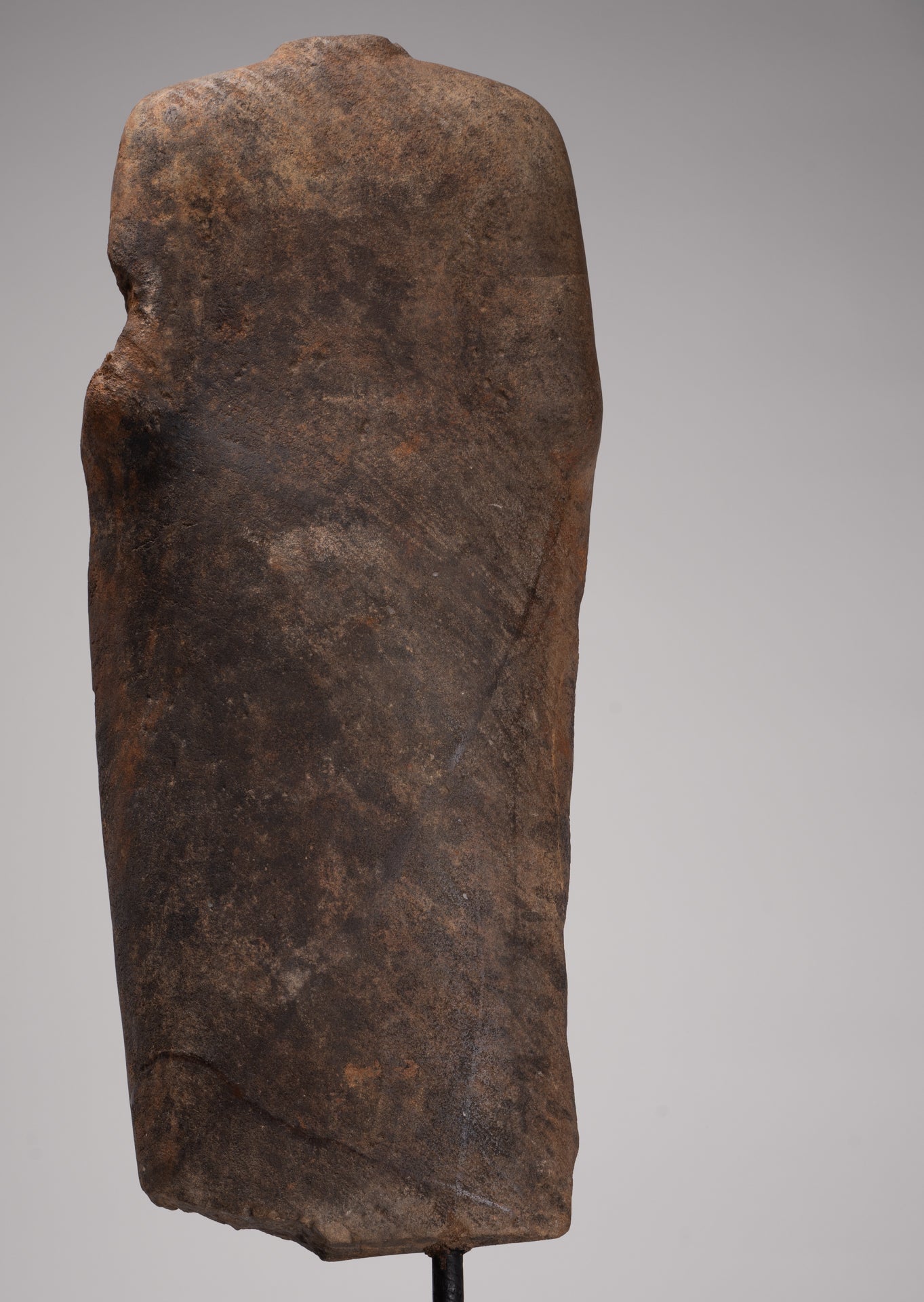-
Buddha Statue - Antique Thai Style Standing Stone Dvaravati Buddha (probably) Statue - 84cm/34" Tall
Measures (Height) 84cm/34"
A sandstone standing Buddha (probably) masterpiece in early 8th century Dvaravati style.
The artistry of Dvaravati Buddha statues, hailing from the ancient region of Dvaravati in Southeast Asia, stands as a testament to the rich cultural tapestry that once flourished in this historical landscape. Characterized by a distinctive style that exudes grace and serenity, these statues encapsulate the spiritual and artistic essence of a bygone era.
As is expected, this Buddha exhibits the hallmark of Dvaravati art with the meticulous attention to symmetry and balanced proportions, with each element carefully measured to convey a sense of harmony and poise.
This imposing sculpture is standing samabhanga, straight legged on a wood base. He is clothed in monastic dress composed of two traditional elements, an undergarment consisting of a long piece of cloth draped around the hips, and a long loose robe that covers both shoulders. The hem of his robes he holds in his left hand.
The clothing sensuously hugs the body revealing the anatomy beneath, a drapery style inspired by early seventh century Thai Dvaravati styles that can be traced back to styles in Gupta period India.
Although the style resembles Dvaravati images carved in Thailand, the present Buddha is more sensuous than most Dvaravati Buddhas. The Buddha here is an appealing blend of Gupta, Dvaravati and Khmer characteristics.
Once arm is broken off near the elbow. The position of the right forearm suggests that the missing hand was performing the vitarka mudra, the gesture of teaching, a common Dvaravati mudra. The slightly different angle of the projecting left forearm indicates that the left hand was depicted holding the ends of his robe, a few folds of which are still visible just below the arm. The Pre-Angkor-period seventh-century Buddha from Kompong Speu, just south of Phnom Penh, is shown in a similar pose with the same hand gestures, but without the wavy edges of the outer robe seen on the present Buddha's robe. The wavy drapery edges can be seen on an early Dvaravati-style Buddha torso in the Thompson Collection said to have come from Lopbur Province in Thailand,' and is an artistic characteristic found in seventh-century Indian art at Nalanda.
This Buddha, with graceful form, invites us to journey back in time to a civilisation where art and spirituality converged in harmonious unity, captivating with their timeless elegance.
The torso, which probably represented Buddha, is carved from sandstone.
Provenance: Ex- private London Collection. All items are guaranteed to be as described. A Certificate of Authenticity will accompany all purchases upon request.
This traditional in appearance piece is sure to add serenity to your home, office or sacred space. One of the most recognisable of the Asian deities this representation of the spiritual teacher Buddha is sure to enlighten your home with endlessly timeless style.
Please note - To aid with safe shipping your Torso will be wood crated before shipping. There is no additional cost for this packing, crating and shipping service.
SATISFACTION GUARANTEE - We have been offering SE Asian Art, through our website and eBay, for many years and are proud of the reputation we have developed for fair and honest listings. However, if for any reason, whatsoever, you are unhappy with your purchase please just let us know and we will provide a full refund. We want you to be 100% happy with your purchase.
-
The majority of orders will be shipped with DHL. This is a secure, express and fully tracked service.
Items less than 2Kg we typically ship using Royal Mail.
Once we receive your order we try to ship all orders the same or next working day.
Large and/or fragile pieces requiring palletising, specialist crating and/or extra packaging may take a little longer. Palletised shipments will be delivered curbside.
All orders over 35 GBP will be shipped free of charge.

-
We genuinely hope that all purchases delight.
However, if they do not, regardless of reason, we will refund all orders upon receipt of the unwanted item. Just notify us within 14 days of receiving your order that you wish to make a return and send the piece back to us with 30 days of delivery.
Let Us Help You Find The Piece You Desire
Let Us Help You Find The Piece You Desire
The Buddha arrived earlier, very impressed. It goes very well with the rest of my collection. A unique piece. I'm sure I'll be back to purchase some more items (when I finish decorating...). Many thanks again.
Mark, Birmingham, UK
Just got the Burmese piece. Thanks for the meticulous packaging, It's very lovely! Thanks again!
Ted, Princeton, NJ, USA
I am over the moon with the two Buddha I bought from you, needless to say... I will be buying again.
Chotika, Nottingham, UK














































